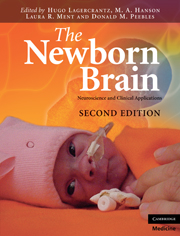Book contents
- Frontmatter
- Contents
- List of contributors
- Preface to the First Edition
- Preface to the Second Edition
- 1 Reflections on the origins of the human brain
- Section 1 Making of the brain
- Section 2 Sensory systems and behavior
- Section 3 Radiological and neurophysiological investigations
- Section 4 Clinical aspects
- 16 Infection, inflammation, and damage to fetal and perinatal brain
- 17 Hypoxic–ischemic encephalopathy
- 18 Clinical assessment and therapeutic interventions for hypoxic–ischemic encephalopathy in the full-term infant
- 19 Clinical aspects of brain injury in the preterm infant
- Section 5 Follow-up
- Section 6 Consciousness
- Index
- Plate section
- References
19 - Clinical aspects of brain injury in the preterm infant
from Section 4 - Clinical aspects
Published online by Cambridge University Press: 01 March 2011
- Frontmatter
- Contents
- List of contributors
- Preface to the First Edition
- Preface to the Second Edition
- 1 Reflections on the origins of the human brain
- Section 1 Making of the brain
- Section 2 Sensory systems and behavior
- Section 3 Radiological and neurophysiological investigations
- Section 4 Clinical aspects
- 16 Infection, inflammation, and damage to fetal and perinatal brain
- 17 Hypoxic–ischemic encephalopathy
- 18 Clinical assessment and therapeutic interventions for hypoxic–ischemic encephalopathy in the full-term infant
- 19 Clinical aspects of brain injury in the preterm infant
- Section 5 Follow-up
- Section 6 Consciousness
- Index
- Plate section
- References
Summary
Introduction
After about 32 weeks' gestation, the neurodevelopmental outcome of premature infants appears to be independent of gestation. However, before 32 weeks there is an almost linear relationship between IQ measured later in life and the gestation at which the baby was born. This was shown by a study of the neurodevelopmental outcome of preterm infants by Wolke and colleagues (2001). The authors assessed IQ at 4 years and 8 months. They considered the relationship between medical and social risk factors using data from the Bavarian Longitudinal Study, which had investigated the cognitive and behavioral development of children considered to be vulnerable because of neonatal adversity. Their conclusion was that cognitive and school outcome for infants born before 32 weeks' gestation was better predicted by neonatal risk (by which they meant prematurity and low birthweight) than social factors. The reverse was true for more mature infants. These data fit well with more recent information from very immature infants born before 26 weeks. A UK cohort of very premature babies born in 2000 were included in the Epicure study (see below), which looked at their outcome when they were 6 years old (Marlow et al.,2005). The data from Bavaria and the UK have been combined in Fig. 19.1.
Thus, if birth occurs before about 32 weeks, the more premature an individual is, the greater the degree of disability.
- Type
- Chapter
- Information
- The Newborn BrainNeuroscience and Clinical Applications, pp. 301 - 328Publisher: Cambridge University PressPrint publication year: 2010
References
- 1
- Cited by

